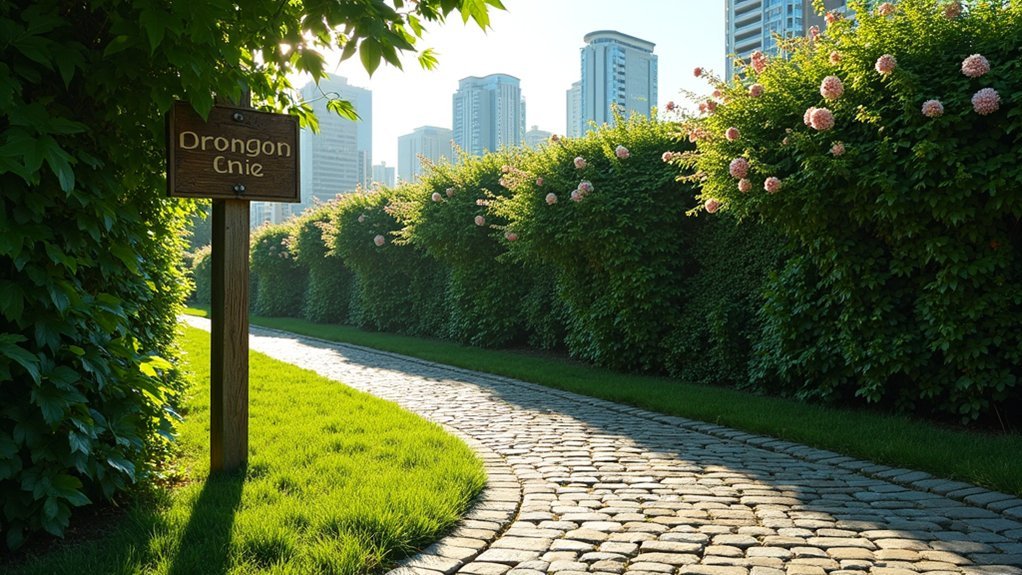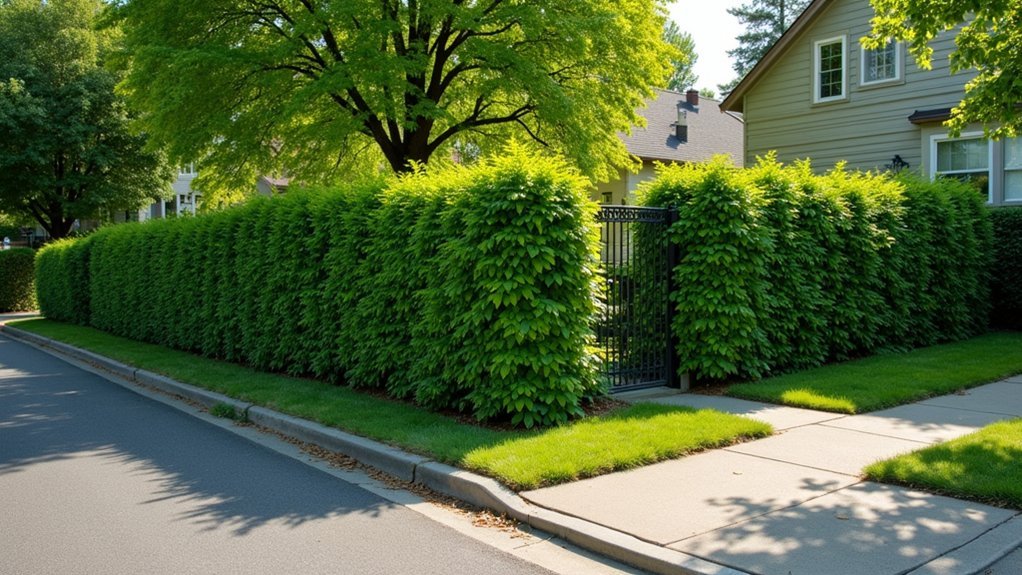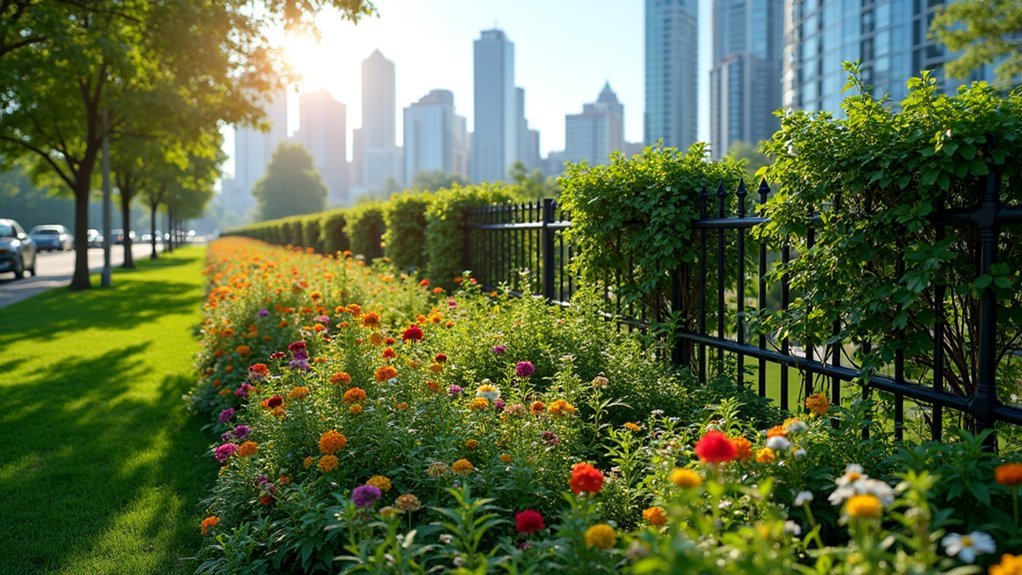City legal guidelines for living fences typically include height limits (3.5 feet for front yards, 8 feet for backyards), setback requirements (3-10 feet from property lines), permitted plant species restrictions, visibility requirements (15×15 foot clear triangles at corners), maintenance standards, property owner responsibilities, and permit application processes. You’ll need to verify local regulations for your specific area, as non-compliance can result in fines or removal orders. The following guidelines will help you navigate these requirements smoothly.
7 City Legal Guidelines for Living Fences

While living fences offer an attractive alternative to traditional barriers, they’re still subject to various municipal regulations.
You’ll need to research your local zoning ordinances regarding height restrictions and maintenance requirements before installation. Many cities have specific rules about plant selection, prohibiting invasive species or plants that block visibility at intersections.
You must maintain your living fence in a neat condition to comply with property upkeep standards and neighborhood aesthetic requirements.
Be mindful of property lines when planting to prevent encroachment onto neighboring land, which could lead to boundary disputes. Respect setback requirements, especially near street corners.
Check with your local planning department about permit requirements, as these vary greatly between municipalities.
Some areas require approval before installing or greatly altering living fences, particularly in historic districts or planned communities.
Height Restrictions for Natural Barriers in Residential Areas
Your front yard living fence must generally stay below 3.5 feet tall, with anything higher requiring approval from local planning authorities.
In contrast, your backyard offers more flexibility, allowing natural barriers to reach up to 8 feet in height.
You’ll need to verify these requirements with your specific city ordinances, as height regulations for living fences vary by location.
Front Yard Considerations
How high can your front yard hedge grow before running afoul of local regulations? For most residential areas, you’ll need to maintain living fences at a maximum height of 3 to 3.5 feet. This restriction guarantees proper visibility while preserving neighborhood aesthetics.
Before installing any front yard fence, you’ll need approval from the Houston Planning and Development Department. When selecting plants, choose species that not only meet height requirements but also thrive in local soil and climate conditions.
Remember to respect the visibility triangle rule—keep the 15×15 feet area near intersections clear of obstructions to protect pedestrian and vehicular safety.
Regular pruning and maintenance of your living fence is crucial to avoid violations that could result in fines or mandatory removal of overgrown barriers.
Backyard Maximum Limits
Unlike front yard restrictions, backyard living fences can reach heights of up to 8 feet without requiring a permit in most residential areas. Your natural barrier along the property line must comply with these height regulations, just like traditional fencing materials.
| Fence Type | Max Height | Permit Required | Compliance Notes |
|---|---|---|---|
| Living Fence | 8 feet | No | Regular pruning needed |
| Living Fence | >8 feet | Yes | Building permit required |
| Hedge Barrier | 8 feet | No | Must maintain visibility |
| Mixed Materials | 8 feet | No | Combined height applies |
Remember that exceeding the 8-foot fence height limit will trigger the need for a building permit. You’ll need to ascertain your living fence doesn’t obstruct visibility at intersections or driveways. Regular maintenance is essential to keep your natural barrier within legal height restrictions.
Permitted Plant Species for Property Boundary Fences

Selecting the right plant species for your living fence isn’t just about aesthetics—it’s a legal requirement in many municipalities. Before planting, you’ll need to check your local regulations to verify your chosen species comply with permitted species lists. Non-invasive plants that thrive in your climate while supporting local ecosystems should be your priority.
- Native options like yaupon holly, wax myrtle, and eastern red cedar offer privacy while providing wildlife habitat.
- Height restrictions for living fences often mirror traditional fencing limits—confirm these before planting.
- Regular pruning is necessary to maintain compliance with municipal height and density requirements.
- Non-compliant species can result in fines and mandatory removal, so research before investing.
Remember that proper maintenance isn’t just good gardening—it’s essential for keeping your living fence legally compliant.
Setback Requirements for Living Fence Installations
Regardless of your property’s location, you’ll need to follow specific setback requirements when planting living fences, which typically range from 3-10 feet from boundary lines depending on your local jurisdiction.
If you’re installing a fence near street corners, you must maintain visibility clearances—often a 15′ x 15′ zone—to guarantee traffic safety and prevent obstruction of sightlines.
Your fence’s permitted height may directly correlate with its distance from property lines, with taller vegetation generally requiring greater setbacks to comply with local ordinances.
Boundary Line Restrictions
While planning your living fence, you’ll need to navigate the often complex world of setback requirements that govern how close you can plant to property lines.
These restrictions vary greatly by jurisdiction, with many cities requiring specific distances from boundary lines to guarantee your fence installation will comply with local zoning laws.
You should be particularly aware of:
- Required setbacks from public roads (often 10 feet or more) to maintain visibility for drivers and pedestrians
- Different height restrictions for living fences compared to traditional fencing, especially in front yards
- Potential legal consequences for non-compliance, including fines or removal orders
- The importance of consulting your city’s specific ordinances before planting to avoid future issues
Proactively researching these requirements will save you both time and potential legal headaches.
Street Corner Visibility
Beyond general boundary considerations, street corner visibility demands special attention for living fence installations. If you’re planning a living fence on a corner lot, you’ll need to maintain a “visibility triangle” to guarantee driver safety.
Most local ordinances require corner lot fences to be set back 10-15 feet from the curb at intersections. Within this visibility triangle, keep living fences under 3-4 feet tall to prevent blocking sightlines.
| Setback Requirements | Typical Guidelines |
|---|---|
| Distance from curb | 10-15 feet |
| Maximum height | 3-4 feet in visibility triangle |
| Non-compliance consequences | Fines and mandatory removal |
Check with your city’s planning department before installation as setback requirements vary by jurisdiction. Adherence prevents safety hazards and expensive corrections later.
Height Versus Distance
Setback requirements for living fences operate on a sliding scale that balances height with distance from property boundaries. As your living fence grows taller, you’ll typically need to position it farther from property lines. Most municipalities enforce setbacks ranging from 3 to 10 feet, depending on the fence’s ultimate height and your specific zoning regulations.
- Taller living fences (6-8 feet) generally require greater setbacks from property lines.
- Corner properties face stricter setback requirements to maintain visibility triangles.
- Front yard living fences often have more restrictive height limits than side or rear installations.
- Stepped designs may be permitted, allowing taller sections farther from property lines.
Always check your local ordinances before planting, as violating setback requirements can result in costly removal or trimming mandates even after your living fence is established.
Maintenance Standards and Property Owner Responsibilities
The upkeep of living fences comes with specific legal obligations that you’ll need to follow as a property owner.
You’re responsible for maintaining your fences in safe, presentable condition, promptly replacing broken or defective components to prevent hazards.
Your fence is subject to city inspections, and if officials find it inadequately maintained, they’ll tag it for remediation.
Ignoring these maintenance standards constitutes a violation of city ordinance, potentially triggering enforcement actions against you.
If you fail to address unsafe fence conditions, the city may complete necessary repairs at your expense, placing these costs as a lien on your property.
To avoid penalties and guarantee compliance, you must adhere to all maintenance requirements outlined in the city regulations that govern fence safety and aesthetics.
Visibility Requirements at Street Corners and Driveways

Living fences near street corners and driveways must comply with strict visibility requirements to protect public safety.
You’ll need to maintain a clear visibility triangle of 15 feet by 15 feet at all street corners to guarantee drivers and pedestrians have proper sightlines. The same concept applies to your driveway entrances, where fence design mustn’t obstruct views of oncoming traffic.
Within these visibility triangles, your fence height shouldn’t exceed 3 feet.
Safety first: Keep visibility triangle fences under 3 feet to protect pedestrians and drivers at key intersections.
Remember that non-compliance can result in fines or required modifications to your fence.
- Create decorative yet compliant corner designs that enhance rather than obstruct
- Consider transparent or open-style fencing at critical visibility points
- Use shorter plants or graduated heights approaching corners and driveways
- Review local ordinances for specific design requirements in your area
Permit Application Process for Natural Fence Construction
Most natural fence installations require proper permits before you can break ground, especially for structures exceeding 8 feet in height.
To begin the permit application process, create an account on the iPermits platform and complete the building permit application with all required information.
You’ll need to pay applicable plan review fees and wait for an email invitation to upload your site plans and design drawings. These documents should clearly show your proposed living fence’s dimensions and materials.
When building a fence, remember to keep approved plans on-site during construction for inspection purposes. This guarantees compliance with local zoning ordinances throughout the installation process.
Always consult with your Planning and Development Department for specific requirements in your area, as regulations for natural fences may vary by location.
Frequently Asked Questions
What Is the New Law on Fences in Texas?
You’ll need permits for fences over 8 feet tall or made of masonry/concrete. Height limits are 3-4 feet for front yards and up to 8 feet for back/side yards without permits. Barbed wire is prohibited.
How Close to My Property Line Can I Put a Fence?
In Texas, you can typically build directly on your property line. However, check your local zoning ordinances first, as some cities like Denton require specific setbacks from public roads or other boundaries.
What Are the Fence Laws in California?
In California, you can build fences up to 6 feet tall without permits. You’ll need neighbor agreement for boundary fences per Civil Code 841, and you must follow your local zoning ordinances regarding height, materials, and placement.
What Happens if You Install a Fence Without a Permit?
You’ll likely face citations and fines from local authorities. You may be required to remove the fence or modify it to meet regulations. Each day of non-compliance can count as a separate violation, increasing penalties.
In Summary
You’ll save yourself headaches by checking these legal guidelines before planting your living fence. Remember to measure carefully for height and setback requirements, select only permitted species, and maintain your natural barrier regularly. Don’t forget visibility considerations at corners and driveways. Submit your permit application early, following all local protocols. With proper planning, your green boundary will enhance your property while staying code-compliant.





Leave a Reply